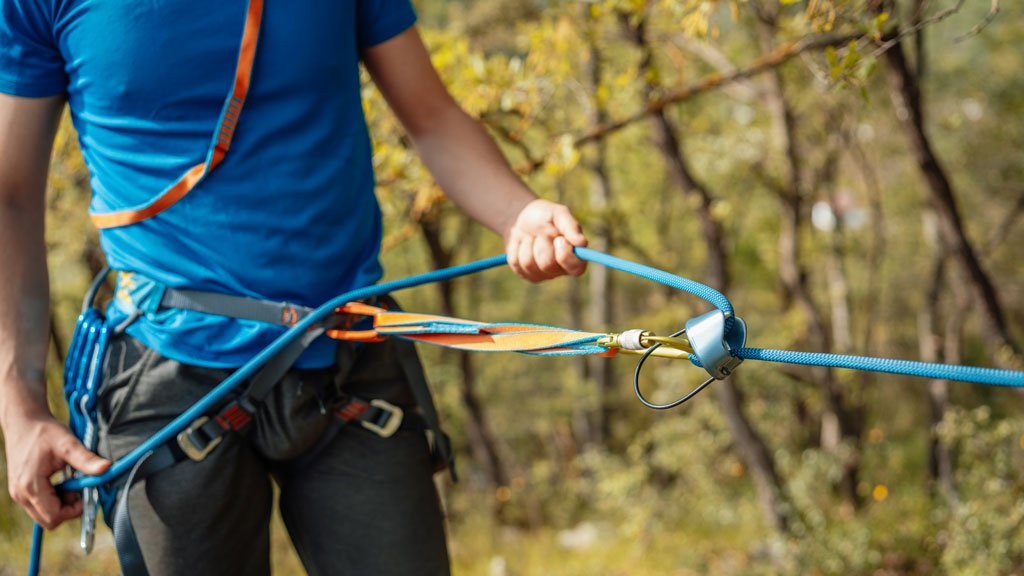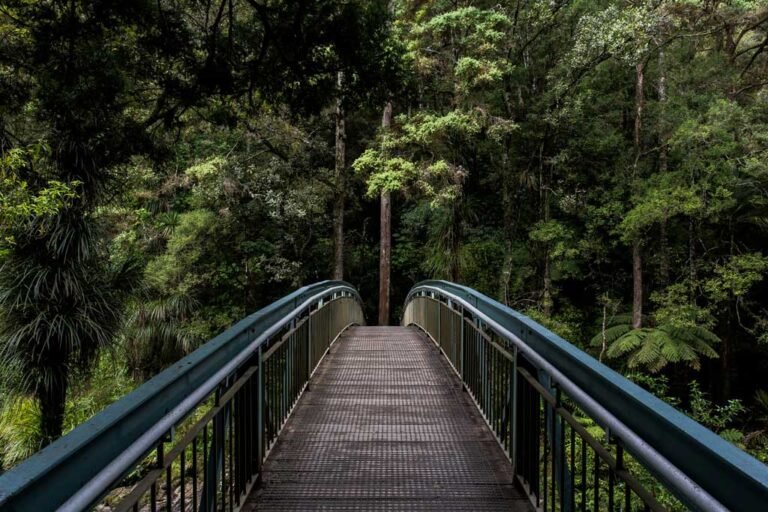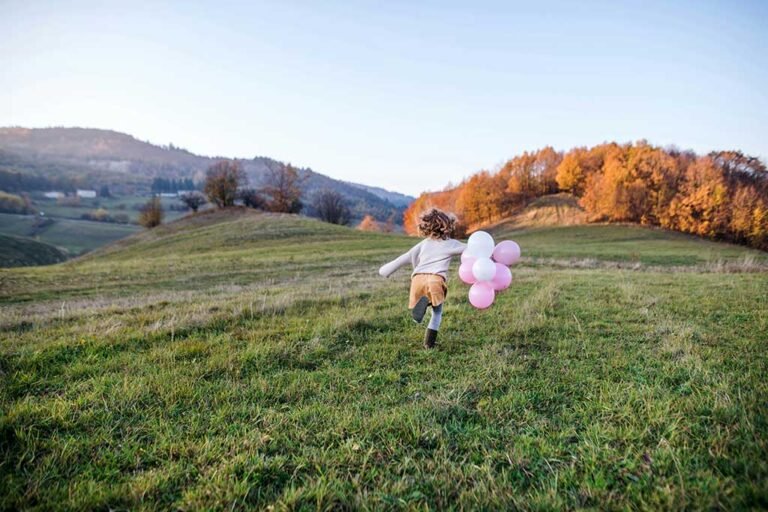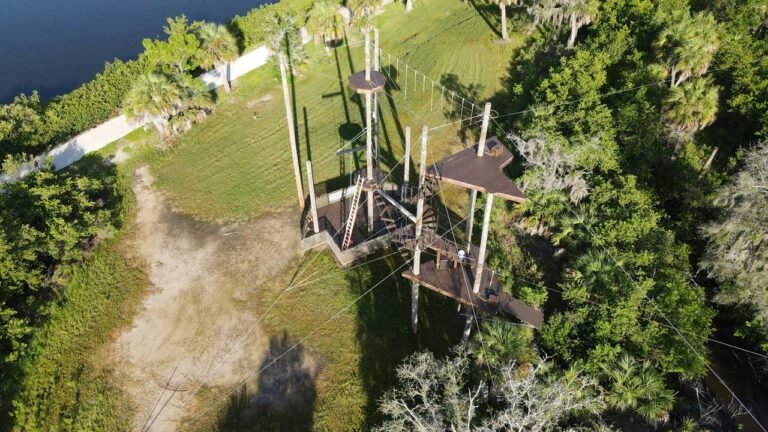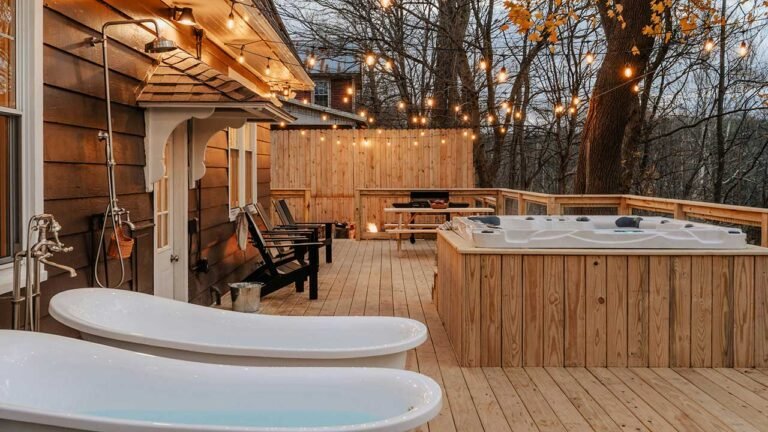Safety in climbing parks and high ropes courses
Immerse yourself in the fascinating world of nature and awaken your passion for climbing! Whether you want to experience this exciting activity for the first time or are already an experienced climber – climbing parks offer an ideal destination for everyone. Enjoy an unforgettable day, whether alone, with your family, at a club outing, a company party, a children’s birthday party or a school class. An adventure in the countryside that you will remember for a long time. Climbing is not only incredibly fun, it also helps you to discover your body in a new way.
Modern climbing parks combine traditional climbing techniques with the latest technology. In Germany, you will find numerous wonderful facilities that perfectly combine safety and fun. Here you can concentrate fully on the course without having to worry about safety.
Whether rolling, balancing, crawling, climbing, bouncing, swinging, jumping or climbing – every element of your climbing adventure is designed to offer you an exciting experience. With a little creativity and courage, you can overcome all challenges. Thanks to different levels of difficulty, everyone will find just the right challenge, regardless of their ability.
Are climbing parks safe?
Climbing parks are a paradise for all adventure-seekers, whether beginners or experienced climbers. Thanks to comprehensive safety measures, you can concentrate fully on the experience. During your visit, you will receive full equipment consisting of a helmet, harness and safety set. This equipment meets the latest safety standards and is regularly maintained and inspected.
Before the ascent, every visitor is thoroughly instructed in the safety technology. Trained employees attach the safety ropes and carry out a careful check. In addition, there are special instruction courses on the ground that teach beginners the basic safety techniques. Under the supervision of experienced climbing park supervisors, you can complete these practice courses and be optimally prepared for your climbing adventure.
Modern safety systems in climbing parks offer additional safety. A common system is the 2-carabiner belay system. You are continuously secured by a steel guide rope to which two attachment ropes from your body harness are clipped. This double carabiner technology offers double protection. At transition points between the climbing elements, only one carabiner is clipped on at a time, which means that you are always securely attached to the lead rope before the second rope is clipped on. This method minimizes the risk and increases your safety throughout the course.
With such advanced safety concepts, climbing parks offer a safe environment in which you can enjoy climbing without any worries. Come along and experience for yourself how exciting and safe climbing can be in our modern climbing parks!
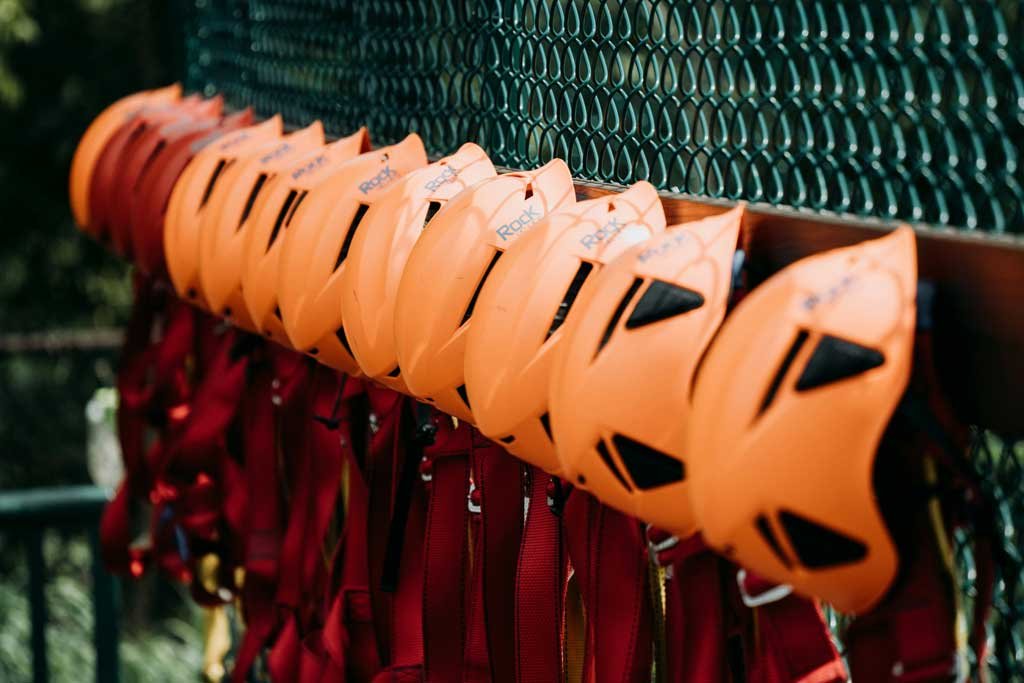
Classic safety systems in the climbing park
In climbing parks that operate without a permanent safety system, the responsibility lies with the climbers themselves, which leads to a deep sense of cooperation and mutual trust. This system, often known as the “classic security system”, is widespread and popular.
Each climber is assigned a reliable climbing partner to work with during the visit. You are responsible for each other and ensure that the safety ropes are handled correctly and safely. Attentive monitoring and coordination are particularly important at the rope suspension points: you give each other acoustic signals to guide the ropes safely from one point to the next.
The classic toprope belay, a special technique of this system, is particularly popular in high ropes courses. With this method, the rope is deflected at the top and the partner belays from the ground. This not only offers safety, but also the flexibility to take a break or abseil down in a controlled manner at any time. It is ideal for practicing techniques, boosts confidence and promotes teamwork.
This system makes it possible for several participants to climb at the same time, with a trained supervisor always present. Although more supervisors are needed, which increases the personnel and time required, the technology remains efficient and cost-effective in terms of materials. Their ease of use and high level of safety make them a popular choice for climbing enthusiasts.
The classic belay system gives you the freedom to test and develop your climbing skills without restrictions. It provides a safe environment where you can focus on improving your technique while enjoying the irreplaceable experience of teamwork. Come to the climbing park and experience how satisfying and fulfilling climbing with a partner can be!
Self-belaying when climbing
Many climbing parks and high ropes courses use the innovative and proven method of self-belaying, which allows climbers to actively participate in their own safety. This not only promotes self-confidence, but also an understanding of the safety measures. Here are the two most popular self-belay systems:
Cowtail fuse
This user-friendly system is often found in adventure parks. It consists of safety sets with carabiners that are easy to handle. Before the start, you will be carefully instructed to ensure that you are familiar with the technique and can climb safely on your own. The cowtail lock allows you to attach one carabiner at a time while the other always remains secured.
Permanent security systems
Many climbing parks use advanced technologies to improve safety. The permanent belay systems have two “communicating” pulley carabiners that technically prevent both carabiners from being unhooked at the same time. These systems are designed so that only one of the carabiners can be opened, which maximizes safety and prevents accidental unhooking.
Both systems are designed to make the climbing experience safer and more autonomous. They offer you the opportunity to climb under your own responsibility, supported by state-of-the-art safety technologies.
Climbing in a high ropes course is basically comparable to using a playground, and here too the risk of injury is reduced to a minimum thanks to the design.
Innovative rail systems in climbing parks
Advanced rail safety systems are used in selected climbing parks and high ropes courses, offering maximum safety. These systems allow you to concentrate fully on climbing from the beginning to the end of the course without having to worry about attaching and detaching safety ropes. A short but thorough briefing by trained staff is all you need to get you safely on your way.
This TÜV-certified belaying method is particularly suitable for children and climbing beginners as it is extremely user-friendly and safe. It enables everyone, regardless of experience, to experience the joy of climbing in a safe and controlled environment.
Although this technology cannot be implemented everywhere and the costs for installation are higher, rail systems represent the state of the art in safety technology in climbing parks. They offer an unbeatable combination of safety and user-friendliness that enriches and improves the climbing experience for all visitors.
Safety requirements and test methods for climbing parks and high ropes courses
The EN 17109:2020 standard specifies safety requirements and test methods for components of an individual safety system for protection against falls from a height used in permanent and mobile ropes courses, as defined in the EN 15567-1 standard.
The EN 15567-1:2015 standard specifies safety requirements for the construction, inspection and maintenance of high ropes courses and their components. It applies to both permanent and mobile ropes courses and does not cover temporary ropes courses or children’s playgrounds.
In the standard, high ropes courses are defined as facilities consisting of several elements, usually made of wire ropes, wooden or metal structures, installed at a certain height above the ground. These facilities are designed to lead through various physical challenges and obstacles and are often used in recreational and training environments.
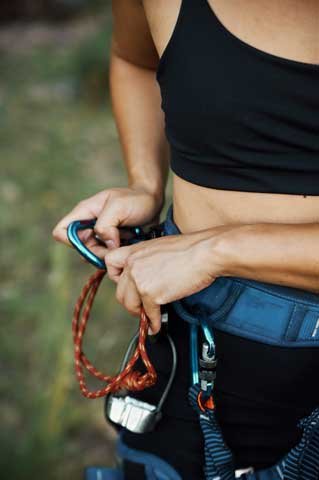
The specific requirements include, among others:
- Dimensions and materials of wire ropes
- Structural materials
- Specific personal protective equipment (PPE)
- Security systems
- Requirements for tree appraisals when trees are used as structural elements
The standard requires regular inspections of the systems, both by users and by certified inspectors, to ensure continuous compliance with safety standards.
Classification of the security systems
The EN 17109 standard divides safety systems into categories A, B, C, D and E:
- Category A: This includes continuous security systems in which the user’s connection to the security system is not disconnected during the entire period of use.
- Category B: This includes systems with a semi-continuous fuse in which the connection is disconnected and reconnected at certain points.
- Category C: These are systems that require a manual changeover, whereby the user must actively disconnect and reconnect at a new point.
- Category D: This category includes hybrid systems that combine elements of continuous and semi-continuous backup.
- Category E: These are special systems that have been developed for specific, often unusual applications and do not fit into the other categories
This classification helps to select the appropriate safety system depending on the type and requirements of the ropes course and the specific safety needs of the users.
In addition, the safety systems in ropes courses are divided into different types, which represent the different requirements for the supervision relationship between supervisors and users. These types refer to the intensity of supervision and support required to ensure the safety of users.
The different types of safety systems are not directly defined in the EN 17109 standard. It specifies the general requirements to ensure the safety of users, but detailed classifications such as type 1, type 2, etc. are not part of the standard.
For detailed classifications and specific safety requirements of the individual types, reference can be made to related standards and documentation, such as standard EN 15567-1, which contains specific requirements and definitions for ropes courses.
Types of security systems
Overview of the types:
Type 1: Description: Systems that enable independent use by users without the need for constant monitoring by a supervisor. Example: Smart Belay, Speedrunner, Saferoller.
Type 2: Description: Systems that require limited supervision by caregivers. Users can largely move around independently, but occasional support from supervisors is necessary. Example: Semi-continuous systems such as CLiC-iT and LockD.
Type 3: Description: Systems that require intensive monitoring and support from supervisors. Supervisors must actively intervene in the process to ensure user safety. Example: Manual security systems such as SmartSnap.
Overview of various security systems
Smart Belay X
The Smart Belay X from Edelrid is an advanced belay system for high ropes courses that offers end-to-end safety thanks to its innovative magnetic technology. It features communicating pulley carabiners that ensure the user is always secured without the possibility of complete unclipping. The system is modular, easy to integrate and enables smooth overtaking operations. It is adaptable for all common safety cable heights and includes integrated steel pulleys for rope slides.
You can find more information on the Edelrid website and in the video below.
Speedrunner from Kanopeo
The Speedrunner® is a free-running safety solution for climbing parks and forest ropes courses. With the safety line at half height, it can be quickly adapted to many situations. The certified mobile lanyard (PPE) Kanhook is a hook-based system with the industry’s first self-closing splitting mechanism. It is an economical and easy to install system. Designed to withstand wear and tear. Robust, durable and reliable.
The Kanhook® (PSA) glides smoothly and silently along the safety line and follows you wherever you go. You are constantly secured. The safety line is attached at half height (1.4 m – 1.6 m) so that it can be operated by hand if necessary. You can find more information on the Kanopeo website and in the video below.
Saferoller from Kanopeo
The Saferoller® is the world’s first rolling continuous belay system and remains the only system that can be installed with the belay rope out of reach (1.7m to 2.3m above the platform) for maximum adrenaline rush. The Saferoller® Trolley is a certified mobile connection device (PPE) that meets all industry safety standards. Once connected to the safety line, it is impossible to disconnect without the explicit help of an operator. Your safety is guaranteed. From 4 years old, just put it on and roll away. Ideal for Saferoller® Kids Trail and Zip Line courses of any length. You can find more information on the Kanopeo website and in the video below.
CLiC-iT ADVENTURE
Thanks to its magnetic anchor point detection, CLiC-iT can only be hooked onto the safety rope or the designated sleeves. This prevents the user from clipping in at the wrong point. In addition, the two carabiners are connected in such a way that only one can be open at any one time. The CLiC-iT carabiners can only be unhooked when the unlock button is pressed. The CLiC-iT adventure system offers simple, one-handed and therefore ergonomic handling. This makes adventures possible for children from the age of 4.
Security and support from professional staff
In climbing parks, a team of well-trained instructors ensures that you have a safe and enjoyable climbing experience. These supervisors are located throughout the park and are always ready to assist you immediately if required. Even if you climb independently, you are never really alone. There are special regulations for children which, depending on their age, require them to be accompanied by an adult at all times.
Before you explore the exciting climbing courses, you will be thoroughly instructed by professional supervisors on how to handle the equipment and use the safety systems. These safety briefings are essential so that you and your climbing partner can master the challenges safely. During climbing, the supervisors are always available to provide support or answer questions.
Are you interested in a career as a climbing park supervisor?
Training to become a climbing park supervisor is comprehensive and prepares future supervisors to teach safety, effective rescue techniques and sound climbing skills. After successfully completing their examination, they are qualified to competently supervise both individual climbers and larger groups and ensure safety in the park.
The training not only enables supervisors to work in their home park, but also offers them the opportunity to work in other climbing parks. In most cases, only a short period of additional training is required to familiarize yourself with the specific systems and equipment of the new park.
Start your career as a climbing park supervisor and turn your passion for climbing into a career!
Become a supervisor in the climbing park
If you want to become a climbing instructor, there are a few important requirements that you need to fulfill:
- Minimum age: You should be at least 18 years old.
- First aid course: A current first aid course not older than three years is required. If it has been a while since your last course, a refresher course is necessary.
- Physical fitness: A good physical condition is essential, as you often have to climb high and should be able to act quickly to provide support.
- A head for heights and a head for heights: As you will often be working at heights of around 10 meters, a head for heights is a must.
- Social and sporting skills: Enjoying working with people and sporting skills are equally important.
- Climbing experience: Previous climbing experience is an advantage in order to be able to carry out your tasks competently.
There are two main training routes in the field of climbing safety:
Supervisor in the climbing forest: In this training course, you will learn everything about equipment and knots, safety management, group supervision, legal aspects and much more. After successfully completing the course and passing a final exam, you will receive official confirmation of your qualification.
Rescuer in the climbing forest: This advanced training requires a previous qualification as a supervisor and deepens your knowledge in advanced knot and material science as well as rescue measures. After the course and a successful exam, you will receive a certificate confirming your skills.
Where does the training take place?
You can complete this training in many climbing forests, climbing parks or high ropes courses. Find out about upcoming courses directly from the parks and start your career in this exciting field.
Safety standards and instructions
All climbing parks in Germany are TÜV-certified and meet the highest safety standards, guaranteeing you a safe working environment. Remember that jewelry should be removed before climbing and that no one should be under the influence of alcohol or drugs. In addition, the carrying of dangerous objects is not permitted.
How did you like this overview of safety standards? Please enter a rating.
You are helping us and other nature lovers. Thank you very much 🙂 !
The directory of high ropes courses in Germany will help you choose the right adventure for you.
You can also find all other categories in the experience search.
FAQ – Frequently asked questions
How safe are climbing parks and high ropes courses?
Climbing parks and high ropes courses are very safe as they are subject to strict safety standards and regular inspections. Modern safety equipment and trained staff also contribute to safety.
What safety equipment is used in climbing parks?
The most important safety equipment includes helmets, climbing harnesses, carabiners and safety ropes. This equipment is thoroughly checked before each use and instruction is provided by specialist staff.
What age and size restrictions are there in climbing parks?
Most climbing parks have minimum age and height requirements, which can vary depending on the difficulty of the course. These restrictions are in place to ensure the safety of participants. Details can be found on the operator’s website and in our adventure descriptions.
What safety measures are there for children in climbing parks?
There are special courses for children with lower heights and easier obstacles. In addition, children usually receive special attention from the instructors.
What happens when the weather is bad in a climbing park?
In extreme weather conditions such as thunderstorms or strong winds, climbing parks are closed for safety reasons. It is important to check the current weather conditions before visiting.
What clothing is suitable for a visit to the climbing park?
Participants should wear comfortable, sporty clothing and sturdy shoes. Jewelry and loose objects should be avoided to prevent injuries.
What should you do if you are afraid or feel insecure?
Participants who are afraid or feel unsafe should tell an instructor immediately. The instructors can then take appropriate measures to ensure the safety and well-being of the person.

